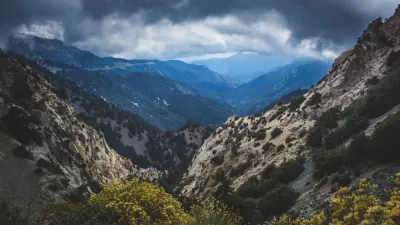An editorial calls for innovative policy in post-fire recovery and reforestation. The recent release of the Environmental Impact Statement for the recovery of the Rim Fire should serve as a barometer for a "new public forestry."
"Something is terribly wrong with California’s national forests, vast public lands that cover 20 percent of our state. According to the U.S. Forest Service, they’re burning up faster than we’re replenishing them. They’re also on track to become net carbon emitters by the middle of this century," reports William Kade Keye.
To put the scale of deforestation by forest fire in some context: "Imagine a continuous swath of fire-charred trees 1.9 miles wide stretching from Los Angeles to San Francisco. That’s how much of California’s national forests have been converted to “deforested conditions” just this century."
The article includes a primer on the history of national forest management policy, as well as the current state of policy and the impact of climate change on the size and severity of forest fires.
On the latter point: "Post-fire recovery and reforestation, including tree planting, is expensive. It requires public support and investment. A reliable funding source is the sale of dead timber to nearby sawmills. Unfortunately, some activists have vigorously – often successfully – opposed post-fire salvage logging. Stopping all commercial harvesting, even that required to clear dead trees for reforestation, has become an ideological badge of honor."
The editorial instead recommends active management of forests, which Keye argues will modify future wildfire impact. The Forest Service, says Keye, needs t win this next test: "The Stanislaus [National Forest] has just released its draft environmental impact statement, which supports carefully targeted salvage logging in advance of urgently needed reforestation. Alarming voices, citing dubious science, will line up in opposition, doing everything they can to maintain the failed status quo."
FULL STORY: Viewpoints: Don’t let our burned-out national forests become a ‘national ashtray’

Study: Maui’s Plan to Convert Vacation Rentals to Long-Term Housing Could Cause Nearly $1 Billion Economic Loss
The plan would reduce visitor accommodation by 25,% resulting in 1,900 jobs lost.

Alabama: Trump Terminates Settlements for Black Communities Harmed By Raw Sewage
Trump deemed the landmark civil rights agreement “illegal DEI and environmental justice policy.”

North Texas Transit Leaders Tout Benefits of TOD for Growing Region
At a summit focused on transit-oriented development, policymakers discussed how North Texas’ expanded light rail system can serve as a tool for economic growth.

San Diego County Sees a Rise in Urban Coyotes
San Diego County experiences a rise in urban coyotes, as sightings become prevalent throughout its urban neighbourhoods and surrounding areas.

Los Angeles County Invests in Wildfire Recovery for Parks, Trails, and Open Space
The $4.25 million RESTORE Program supports the recovery of parks, trails, and open spaces damaged by the January 2025 wildfires through targeted grants that promote community healing, wildfire resilience, and equitable access to nature.

Nevada Bills Aim to Establish Home Insurance Assurance Amidst Wildfire Risk
Republican sponsor hopes the FAIR plan would be “a true market of last resort.”
Urban Design for Planners 1: Software Tools
This six-course series explores essential urban design concepts using open source software and equips planners with the tools they need to participate fully in the urban design process.
Planning for Universal Design
Learn the tools for implementing Universal Design in planning regulations.
Alamo Area Metropolitan Planning Organization
City of Santa Clarita
Institute for Housing and Urban Development Studies (IHS)
City of Grandview
Harvard GSD Executive Education
Toledo-Lucas County Plan Commissions
Salt Lake City
NYU Wagner Graduate School of Public Service




























